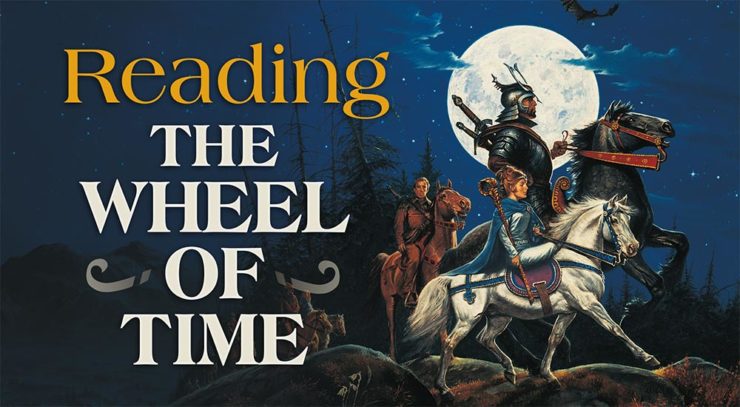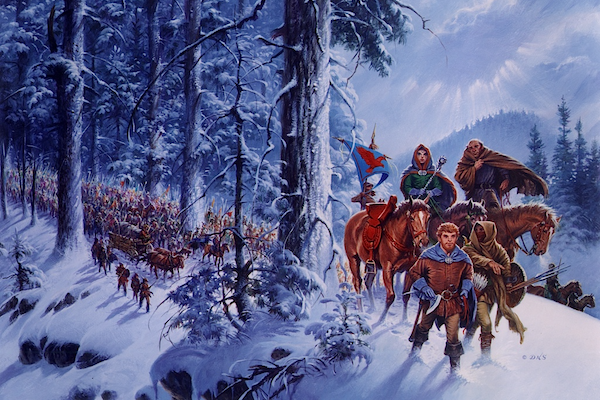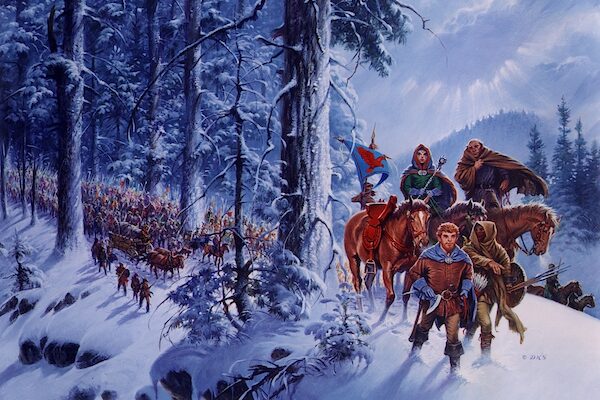Well this is it. Part 19 of Reading The Wheel of Time, covering Chapters 50 and 51. There will be a part 20 next week, but this is the section in which all the action goes down. I have to admit, I had a difficult time recapping this one; when a chapter is mostly action it just starts to feel like I’m just plagiarizing the actual narration, and there’s a lot, particularly in Chapter 51, that is both complicated and unexplained. Also, I went on a sidetrack thinking about the Green Man. His death made me so sad.
Everyone follows the Green Man, and Rand is in awe of him even as he wonders uneasily what the Green Man meant when he called him “Child of the Dragon.” He also notices Perrin walking as far away from the Green Man as possible.
Despite Rand’s uneasiness, however, the peace of the place affects him, dispelling his fear and drawing him in with its beauty. The “thousands of burning points” of pain that he felt as he struggled with his flight or fight urge against the worms are gone now, and Rand believes that it is the Green Man himself who put them out.
The Green Man walks through his beautiful groves, plucking flowers to weave into the women’s hair and helping seeds to sprout and plants to grow straighter and taller. Rand can tell by their expressions that Egwene and Nynaeve can feel the peace of the place, and he and Egwene share a smile as he thinks about how pretty she is, and how determined he is to protect her.
And then they reach the Eye. In the center of the forest is a simple stone archway, its entrance shadowed, its keystone bearing the ancient symbol of the Aes Sedai, “a circle halved by a sinuous line, one half rough, the other smooth.” For a moment everyone is still, and then as Moiraine takes the garland from her hair and lays it on the branches of a bush, everyone begins gently suggesting their reluctance to enter, although Moiraine’s will is resolute. The Green Man tells them that about how the Eye was created by male and female Aes Sedai working together, as all the greatest works of the Aes Sedai were made. They made it because of the breaking of the World, and they “died, all, to make it pure.” The Green Man says that he was not made to guard the Eye, but that everything was breaking apart and that he was all they had, so he agreed to what they asked, and has kept the faith ever since. But he does not want to go in to see the Eye with them, because he can feel that his own end is linked to the Eye, somehow. But he says that when everything is over, he hopes to find a new place to make things grow.
Buy the Book
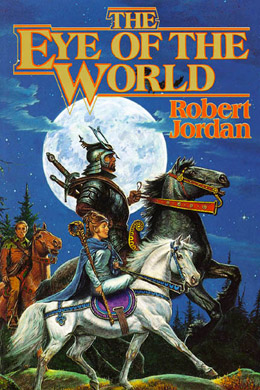

The Eye of the World
The Green Man leaves them (er, I mean, he departs) and they step into the archway, traveling down a tunnel with walls that glow with sparkling white light. Rand can tell that it is not a natural occurrence, but he also senses that it is benign. Still, knowing so doesn’t stop his skin from crawling. They step into a domed chamber, illuminated by glowing crystals, and in the center is an oval-shaped pool, perfectly smooth and clear and yet without a visible bottom. Mat kicks a rock into its surface and the stone sinks without a splash. The image of the rock distorts itself oddly as it sinks, growing larger and somehow almost transparent before it disappears. When Rand asks, hoarsely, what it is, Moiraine explains that it is the essence of saidin, the male half of the Power, enough to mend the seal on the Dark One’s prison, or to destroy it. She explains how no one living knows how the Eye was was made or why; they know only that the Aes Sedai who made it foresaw a great need, and that they worked through the taint to make it pure, knowing that such a feat would cost them their lives. And as she explains she watches the three boys.
Rand and Mat have thrown themselves backwards against the stone wall of the room, while Perrin has his axe out. Rand asks why she brought them there, and Moiraine’s eyes seem to pull at him as she answers that they are ta’veren, and that it is here in this place that the Dark One will strike, and here that he must be stopped lest darkness will cover the world. She leads them out again, Rand edging against the wall the whole way, unable to bring himself to take even one step closer to the pool, and he’s still shaking when they reach the sunlight again.
Outside in the fresh air, Nynaeve starts to upbraid Moiraine about something when they are interrupted by two hooded figures. Lan asks who they are and if the Green Man guided them; one replies that Mat led them there but that he is not the one they seek. They push back their hoods, revealing one man who looks older and more drawn than anyone Rand has ever seen, while the other wears a black leather mask with a horrible laughing face on it. The withered man introduces himself as Aginor, and his companion as Balthamel, explaining that Balthamel no longer speaks with his tongue, as “The Wheel grinds exceedingly fine over three thousand years imprisoned.”
Mat begins to say that the Forsaken are bound in Shayol Ghul, but Aginor cuts him off, changing “are” to “were.” He tells Moiraine that the seals are weakening, and that soon others of their number will also walk free. He tells them that there is no Lews Therin Kinslayer to save them now, and that they know which one they seek. There is no need for the rest.
Lan draws his sword, torn for an instant because Nynaeve and Moiraine are too far apart for him to step in front of them both, but the second he moves Aginor flicks his fingers and Lan is thrown back hard against the arch and falls to the ground, unconscious. Seeing this, Nynaeve draws her knife and throws herself at Aginor, but Balthamel catches her by the jaw and lifts her off her feet as she wails in despair. Rand stops Egwene from rushing to Nynaeve’s aid by tackling her bodily to the ground, crying out that you can’t fight the Forsaken, but Perrin and Mat draw their weapons and attack, only to be knocked down by an invisible hand.
Aginor tells them that if they abase themselves properly, he might let them live, and the boys and Egwene get to their feet in stubborn defiance. Aginor glances at the archway leading to the Eye, and tells them that now that he has found what he seeks, he may take the time to teach them a lesson. But before he can do anything the Green Man arrives, shouting that the men are not welcome in his place, and that they are not permitted to harm any living thing. Aginor raises a hand and the Green Man begins to smoke, bellowing in pain, but Aginor underestimates him and the Green Man catches Balthamel in his arms and squeezes him tightly. The two struggle, flames bursting from the Green Man’s face under Balthamel’s hands, but then creepers and nettles and fungus begin to grow on the man’s body, and when the Green Man throws him down, mushrooms and all sorts of plants that “love the dank” pull his body apart, leaving him just a dark forest mound.
But the Green Man goes down as well, half his head gone, burning leaves falling to the ground. As his head falls, he cups an acorn and it grows into a massive tree, huge and ancient, with limbs as big as a man, 500 years old or more, its roots curving around Nynaeve’s prone body where Balthamel dropped her. For a moment Aginor is stunned, then he snarls that it is time to end this.
Moiraine agrees, and with an outstretched hand she opens a flaming chasm beneath Aginor’s feet. But the Forsaken stands as if on air, and slowly, pushing against Moiraine’s power, he starts to advance towards her. Straining, she shouts for the others to run, and Mat, Perrin, and Loial all comply. But Egwene, Rand sees, is trying to help Moiraine, trying to use her own power. He grabs her and tells her to run, pushing her into motion, but suddenly Aginor turns toward her.
“Not her!” Rand shouted. “The Light burn you, not her!” He snatched up a rock and threw it, meaning to draw Aginor’s attention. Halfway to the Forsaken’s face, the stone turned to a handful of dust.
He hesitated only a moment, long enough to glance over his shoulder and see that Egwene was hidden in the trees. The flames still surrounded Aginor, patches of his cloak smoldering, but he walked as if he had all the time in the world, and the fire’s rim was near. Rand turned and ran. Behind him he heard Moiraine begin to scream.
Rand runs, uphill, and it’s like Moiraine’s screaming lasts forever, although Rand knows that it’s only a few moments, and therefore a few moments until Aginor follows him. Suddenly he comes to a cliff edge, and although he searches desperately for a hidden trail or some way around, there is nothing. He is about to try to retrace his steps when Aginor finds him. The Forsaken murmurs almost to himself that the man who brings Rand to Shayol Ghul will have rewards beyond mortal dreaming, but that Aginor himself has always had better dreams, and why should he share power or bend knee to Rand when he could serve the Dark Lord in death and it would make no difference to the spread of the Shadow. He mentions that he once stood in the Hall of the Servants and held his ground against the Lord of the Morning, Lews Therin Telamon himself.
Rand, meanwhile, is desperately searching for some way to escape, to get away from Aginor, when he suddenly becomes aware of a bright cord of light that stretches out from Aginor’s body and away into the distance, a cord that pulses and seems to give Aginor strength with each pulse, and yet beside it Aginor seems almost not to exist. The shining cord hums and calls to Rand, and one strand lifts away from the rest and stretches out to touch him.
Rand is instantly filled with warmth and although Aginor screams that Rand “shall not have it,” the two struggle over the power as it fills Rand, as he wraps the void around a small corner of himself and the rest is filled with Light. “Mine!” Aginor screams as flames burst from his mouth and Rand’s mind repeats the same desire to get away.
Suddenly he finds himself in a mountain pass, unable to think for himself, every bit of him subsumed with the Light, leaving him stunned in awe. Around Rand the tail end of battle rages, men and Trollocs and Fades fighting each other and then drawing back to regroup. He finds himself standing before the reforming ranks of the men, seeing that they are already defeated even as they ready themselves for a final charge. Some of them see him and cry out, but the shouts seem to come from a great distance.
Then Rand is facing the enemy, their ranks swollen and terrible. Some of them see him too, and the Dragkhar swoop down to attack; Rand can see them clearly, men’s faces and winged bodies bearing down on him as the heat of the Light burns through him and lightning strikes and kills each one.
Rand falls to his knees, clutching at grass that bursts into flame at his touch, trying to hold on to some part of himself, as he cries out “Please, nooooooo!”
With his screams the flames grow into a wall of fire that speeds away from him, and as he shouts “This has to end!” and pounds his fists,the ground is churned up into waves of earth that crash into and consume the Trolloc hoards, leaving behind only about twice the number of the human army. He yells again.
“The Light blind you, Ba’alzamon! This has to end!”
IT IS NOT HERE.
It was not Rand’s thought, making his skull vibrate.
I WILL TAKE NO PART. ONLY THE CHOSEN ONE CAN DO WHAT MUST BE DONE, IF HE WILL.
“Where?” He did not want to say it, but he could not stop himself. “Where?”
The haze surrounding him parted, leaving a dome of clear, clean air ten spans high, walled by billowing smoke and dust. Steps rose before him, each standing alone and unsupported, stretching up into the murk that obscured the sun.
NOT HERE.
With shouts that the Light wills their victory, the human host charges the Trollocs. For a moment the little bit of Rand that has room for such thoughts is worried about being trampled by combatants, but the rest of him views such concerns as beneath notice, and he climbs the stairs in a timeless void until he comes to the door and chamber from his dreams. The door explodes apart when he touches it, and inside he finds the same setting, the twisted tortured faces, the fireplace, and the mirror on the wall in which he can now see himself perfectly clearly.
Ba’alzamon greets him, remarking that he suspected that Aginor’s greed would overcome him in the end. But it doesn’t matter because the long search is ended, and Ba’alzamon knows Rand now. Rand sees that Ba’alzamon has a cord of his own, as dark as Rand’s is light, and much thicker. He tells Ba’alzamon that he is tired of running and having his friends threatened, and Ba’alzamon retorts that it doesn’t matter if Rand runs or not, that he has tried both before and everything ends the same.
Rand answers that Ba’alzamon does not weave the Pattern, and that every trap lain Rand has avoided or overcome, and that he has tracked Ba’alzamon here after all. This seems to set Ba’alzamon back on his heels for a moment, but then he counters by suggesting that he has been responsible for the entire course of events, letting the right people live to send the right words to Rand’s ears to draw him there. Rand’s confidence wavers then, Ba’alzamon’s knowledge of the details is enough that what he says could be true. But the Light warms him, sends away his doubt, and the void remains steady in his mind. Ba’alzamon continues to insist that he wanted Rand to come here, alive and on his own, so that he could be brought to heel and made to serve. When Rand denies him, he shows Rand an image of Nynaeve and Egwene, and of another woman, one that Rand recognizes as his mother.
Again Rand denies Ba’alzamon, insisting that his mother is dead and safe in the Light, but the apparition of his mother tells him that the Lord of the Grave’s reach is longer than it once was, that he is her master now, and she can only obey him. She begs for Rand’s help, saying only he can save her, as Fades close around her and begin torturing her. Rand draws his sword, a sword made of Light, and a bolt shoots from its tip, cutting through the Fades like paper and destroying them all.
From the midst of the brilliance, he heard a whisper. “Thank you, my son. The Light. The blessed Light.”
The flash faded, and he was alone in the chamber with Ba’alzamon. Ba’alzamon’s eyes burned like the Pit of Doom, but he shied back from the sword as if it truly were the Light itself. “Fool! You will destroy yourself! You cannot wield it so, not yet! Not until I teach you!”
“It is ended,” Rand said, and he swung the sword at Ba’alzamon’s black cord.
The cord is severed and the recoil flings Ba’alzamon into the fireplace. The stone around them begins to crumble as Rand swings the sword toward him again, light shooting from its tip again and crashing into the Dark One, who throws up his arms in vain to shield himself. Rand can feel his own cord weakening and thinning, he is desperate for it to be ended, and then as Ba’alzamon withers and shrieks Rand feels himself falling away.
Buy the Book
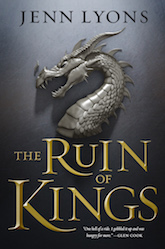

The Ruin of Kings
No one knows the origins of the mythological figure of the green man. He is most commonly associated with the Celts, due to how numerous the depictions of him are in the ancient carvings, stonework, and jewelry of that people, but similar ancient images have been found in the Middle East and India, and many ancient cultures have imagery and deities that fill a similar role of symbolizing growth, rebirth, and man’s relationship with nature. In the case of the ancient Celts, representations of faces or heads was common, often peering out from vestigial carvings, and these images were probably influenced by and in dialogue with similar carvings from Mesopotamia and the Roman images of Dionysus. The Celtic and Roman imagery in particular went on to evolve to be common in Christian stonework, and images of the green man can be found in the walls and pillars of many churches in the U.K. and elsewhere.
Usually the green man is depicted as being made up of foliage, a single leaf with a man’s face or a man’s face with leaves for eyebrows, mustache, vines for a mouth, etc. Other times he is depicted as having foliage growing out of his mouth, his ears, or even his eyes, and some scholars have even named certain images of skulls sprouting foliage as depicting the green man.
Before Christianity, most religions said that man was born from nature, and thus the green man represents that tie. He is an icon of fertility, growth, and rebirth, and therefore linked also to death and decay. Since no one knows the true origins of the image, there is much room for interpretation, and the green man has been linked to Robin Hood, Puck, St. George, and many others. Ultimately we don’t know what symbolism ancient cultures ascribed to the green man, how much was symbolism and how much was simple decoration, and how connected the icon is across disparate cultures. But there is no denying the appeal of the character as one moves forward in history; the Renaissance saw a huge surge in the popularity of the vegetal face as a design motif, and because of his connection to the history of the country, the green man remains particularly popular in England.
But what does all this mean for Rand and his friends? I found it significant that we don’t know what the Green Man is; his species or even if he has a name of his own. No doubt that will come up in some later book, but for now, like the green man of our world, the truth of where he comes from is a mystery, and in a certain way, unimportant. Like nature itself, he just is, and I wonder how his power relates to the Power; saidin and saidar are the force which creates, and we know that Elaida used her power to make things grow. The green man does not create but only helps things along, as he puts it, so it’s a different power but one that interacts with creation in a meaningful way.
There is a paragraph where the Green Man stops to help a seed grow that strikes me as one of the most beautiful thematic moments all of The Eye of the World. The seed is in the center of the path, and the Green Man cups his hand around it, giving it shoots that bypass the rocks and dig down into the good soil below.
“All things must grow where they are, according to the Pattern,” he explained over his shoulder, as if apologizing, “and face the turning of the Wheel, but the Creator will not mind if I give just a little help.”
Rand led Red around the shoot, careful not to let the bay’s hooves crush it. It did not seem right to destroy what the Green Man had done just to avoid an extra step.
Moiraine’s mantra of “The Wheel weaves as the Wheel wills,” is a useful one, but it doesn’t account for her determination to do all she can in the face of the Shadow. She works tirelessly, fights constantly, and risks everything for the duty she has undertaken. If the mantra was truly to be taken at face value, I think it would encourage idleness, suggest that fate is the only thing that matters, and this plays into the question I have been asking about free will and its place in the Wheel of Time universe. The Green Man’s philosophy seems to seamlessly blend both the understanding of the Pattern and of free will and personal responsibility. And it’s also just a beautiful sentiment.
How right the Green Man was to sense his own ending would be tied to the Eye! Not to the object itself, as it turns out, but to the conflict around him. The way that Balthamel, an agent of decay, is fed upon and destroyed by fungi and other plants that break down decaying matter is quite fitting, and shows that even in the act of killing the Green Man is not an agent of destruction but of rebirth. His own death also results in life and strength in another form. Seeing that fight, though, really makes me wonder how the Green Man got the older scar, and if another agent of the Dark One didn’t find the Eye and set this plan in motion in the first place.
Going back for a second to the Eye, I have to admit that it isn’t what I expected! Until Moiraine admitted that no one knew what the Eye was, I thought it was the center of the Wheel of Time. I think I formed that opinion back when Ba’alzamon first told Rand that the Eye would never serve him, and it was only in the last several chapters that I started to realize how mistaken my initial impression was. The foreshadowing of the Eye was done well in the earlier traveling chapters when Rand and the other Two Rivers folk saw the old wonders made by Aes Sedai long ago, like Whitebridge, and whose very composition is a mystery to the people of the present day. The modern Aes Sedai know enough to recognize pure saidin but they have no idea what such a pool, pure or no, would be used for, or how. This is because they cannot channel saidin, but also because there is no record left of the techniques that might have been used to make it in the first place.
Rand and the boys’ aversion to the pool of saidin makes sense, given what happens to male channelers most of the time. But I was a little surprised that Rand didn’t have any other thoughts about it, or any instinct drawing him towards it. Then again, was the Eye’s saidin the cord of Light that first Aginor, then Rand, was wielding? It almost has to be. For a moment I thought that perhaps Aginor was stealing Moiraine’s life force or something like that, but then I remembered the rule about saidin and saidar channelers being unable to use each other’s powers. But if the saidin in the Eye was what Aginor and Rand were using, then it’s going to be empty when Rand gets back to it, right?
There are so many questions raised by the events of Chapter 51 that I don’t know where to start. Rand is clearly being driven by a force beyond his own conscious mind; whether it be instinct, some kind of programming that the Aes Sedai who built the Eye put into it, or the will of the Light itself, I can’t tell. Rand’s use of the void to keep a little piece of himself separate was very interesting to me; it reminded me of the way Richard partitions his mind in The Wizard’s First Rule, to keep his core self from being broken under the Mord Sith torture. Like Richard, Rand doesn’t really have a full idea of what he’s doing, but his training from his father and his instincts guide him to make the partition. But that just brings me back to wondering how much of Rand is directing the proceedings and how much of what he does and even what he says isn’t Rand but someone, or something, else.
Lews Therin Telamon, perhaps? If being the Dragon means being reincarnated, then perhaps an earlier Dragon’s mind can possess the new body his soul now occupies, like how sometimes old Avatars step in to help the most recent one in Avatar: The Last Airbender. That would certainly make sense of the wild rage Rand experiences and the way he wields the Power without even feeling that he is doing it, never mind knowing how to do it. And if that’s the case, maybe Lews was the voice he heard in his mind.
Because seriously what was that? The only other explanation I can think of is that it’s the Creator themself talking. The “I WILL TAKE NO PART” bit kind of suggests that, the idea being that the Creator, like the Christian God, has left the fate of humanity and the world up to free will and the strength of a savior. And then the Creator just… makes him some steps to get to Ba’alzamon. Is Ba’alzamon the “it” or does that refer to something else?
I mean, I get that a lot of this is probably metaphysical and not literal, but either Chapter 52 is going to be full of a lot of musings and explanations or there’s going to be a lot left unanswered by the end of this book.
One question I am having a lot of fun pondering is how much of what Ba’alzamon says is roughly “truth.” I don’t actually believe him when he says that he orchestrated the clues that led Rand to the Eye and to Ba’alzamon himself; when he says that it’s a direct response to Rand reminding him that Ba’alzamon doesn’t weave the Pattern, and I think he’s just trying to save face and keep Rand from feeling that he has any agency in the proceedings. I think Moiraine’s belief that the Pattern itself led them to the right spot at the right moment is much more likely.
I also think that might really be Rand’s mom. At first it seemed like a standard tempter’s trick to show Rand the image of someone he loved and use it as a bargaining tool, but Kari doesn’t talk like that. If she was just an image used by Ba’alzamon to manipulate Rand, she would have begged him to surrender to save her, or to surrender to be with her. Instead she begs him to free her, which Rand does easily, and then she praises the Light. No deception of the Dark One would do that, I am certain. And since we know that Ba’alzamon can take control over the souls of people who have died—he tells Rand that he will do as much to him—it doesn’t necessarily mean that Kari was a Darkfriend or anything like that.
Speaking of Rand protecting people, back when he was having his fever dreams, specifically the one he had riding in Bunt’s cart, I wondered how much was standard nightmare and how much was some kind of vision, and I remember that he saw Egwene imprisoned by a Fade and shouted in his dream, “Not her!… The Light blast you, it’s me you want, not her!” and then at the end of Chapter 51 when he throws the rock at Aginor to distract him from Egwene; “Not her!” Rand shouted. “The Light burn you, not her!” Maybe not a vision, but certainly a nice bit of foreshadowing/call back to earlier.
Next week we will get some answers to some of my questions, find out who is still alive, and learn more about the mystery of the Eye. We are closing into the end of this adventure, dear reader, but that just means that we have gotten to the Beginning. See you next week for Chapters 52 and 53, the last part of The Eye of the World!
Sylas K Barrett once left a flower for the green man in Sherwood forest. It was a moving moment.










